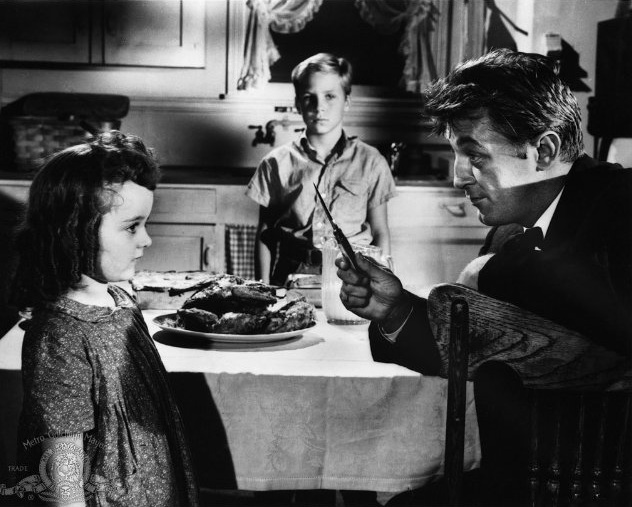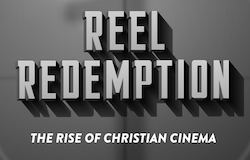One of a Kind, by Tyler Smith
4 Nov
Charles Laughton’s The Night of the Hunter is a beautiful and fascinating work of art. It is a film of intangibles, borrowing its tone and imagery from various genres while never belonging to any of them. Somehow it manages to stand alone, defying categorization. That the film was the sole directorial effort of Laughton – a venerable character actor since the 1930s – only adds to its mystique. Not only is it difficult to speak about the film in regards to genre, but it also sidesteps any discussion of auteurism, as we have no previous nor future works by the director to compare it to. Given the surreal, dreamlike quality of both the visual and thematic elements of the film, it seems appropriate that it would remain so academically elusive. It is a film that insists we first view it on its own terms, rather than try to fit it into any larger theories.
Of course, it is inevitable that a film so far ahead of its time – it’s debatable whether we have even now caught up to it – would confound and frustrate both audiences and critics in 1950s America. While the decade was largely known for its peace and prosperity, the Cold War loomed large over the American psyche, leading to the Korean War and McCarthyism. In any case, there were still clearly-defined lines between “us” and “them”, with the United States seen as the obvious hero and the godless Communists the sneering villains. The Night of the Hunter blurs those lines, with the murderous antagonist being a pious preacher – who has his own unique interpretation of the conflict between good and evil – who preys upon the good faith of simple, hardworking, small town Americans. In a country defined largely by its faith, the idea that such horrendous, predatory evil can come in the guise of a holy man must have been particularly distasteful to audiences.
Critics themselves had a hard time embracing the film, likely viewing its mixing of genre as a series of jarring shifts in tone. And, indeed, it can be unnerving – perhaps even a little off- putting – to see the smooth talking Rev. Harry Powell (Robert Mitchum) reduced to a grunting Karloff-like monster in one scene, only to appear almost lackadaisical the next. Furthermore, to have fairly straightforward depictions of small town America punctuated by expressionistic silhouettes and shimmering close-ups must have been deeply frustrating to those looking for something more concrete to analyze.
However, as more and more films have challenged genre expectations and tonal shifts have become the norm, many of Laughton’s choices start to fall into place. We can now see the different stylistic moods being informed by the story Laughton is telling, rather than a hindrance to it. The sudden changes in perspective and circumstance mimic the rhythms of a dream. Just as in the reality of a dream, the film fluidly moves from drama to comedy to noir to horror and from vérité to surrealism to expressionism. It is Laughton’s commitment to each individual shift – while keeping a keen eye on character and story arc – that sells the disjointed reality of the film. Had he favored one style or genre over another, the balance would be thrown off and the film could have been seen merely as a flawed noir or unfunny comedy rather than one cohesive whole with various working parts.
The outsized world of The Night of the Hunter can also be attributed to its primary perspective; that of John (Billy Chapin) and Pearl (Sally Jane Bruce). While we do occasionally see things from Powell’s twisted point of view, or that of the children’s naive mother, Willa (Shelley Winters), the film eventually settles on the children themselves, for whom the world is still relatively fresh and new. Every person they meet is intimidating, every place they explore overwhelming. And, as the children are eventually pursued by Powell, the shift from reality to expressionistic nightmare (or perhaps a Grimm’s fairy tale) makes more sense; doubly so when the children encounter Mrs. Cooper (Lillian Gish), a firm but benevolent matriarch whose inherent stability begins to influence the visual quality of the film, taking it from surrealistic and exaggerated and bringing it back down to a more safe and manageable place.
These stylistic choices serve to embody one of the film’s predominant themes: the tragic resilience of children. As John’s father (Peter Graves) entrusts him with a doll filled with stolen cash, an enormous burden starts to weigh John down. And, as John is tasked with protecting his young sister from Powell’s villainy, he seems to grow up before our eyes. Only when Mrs. Cooper asserts herself as an authority figure does John start to revert back to normal boyhood again, but never completely. By the end of the film, as John watches as Powell, now a surrogate father (albeit an abusive one) is carted off to jail, the burden becomes too great and he has a complete breakdown, leading to one of the most complex and heartbreaking scenes in film history.
Perhaps this harsh reality – that it is the most innocent of us (children) that often bear the brunt of our mistakes – was more than audiences wanted to confront in post-World War II America. Maybe the image of the idyllic family and cherubic children was too dear to 1950s audiences to embrace a film that suggested that parents – and perhaps adults in general – are perpetually warping and burdening their children with their own flaws and insecurities, if not outright endangering them through war and greed.
Regardless of exactly why audiences and critics didn’t embrace The Night of the Hunter, the film has thankfully been revisited over and over by modern filmgoers interested in a truly unique experience. Charles Laughton may have only directed one film – a sad reality brought on by harsh critical response – but that film stands out as a masterpiece of visual storytelling, realized by a director whose commitment to his vision was both unwavering and uncompromising.




No comments yet